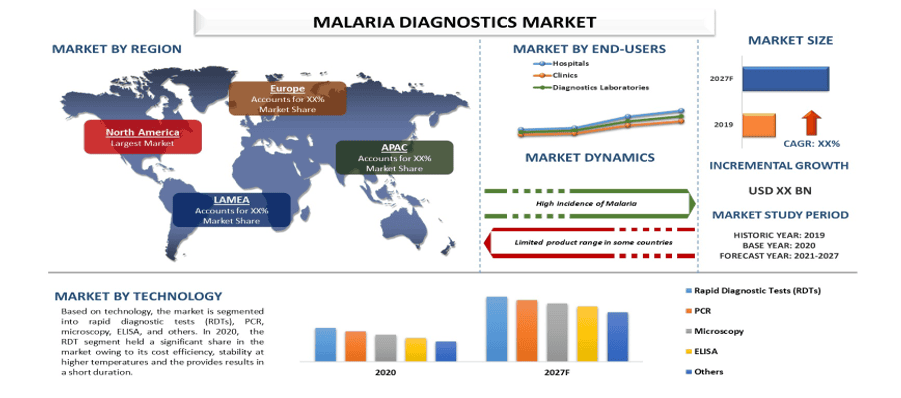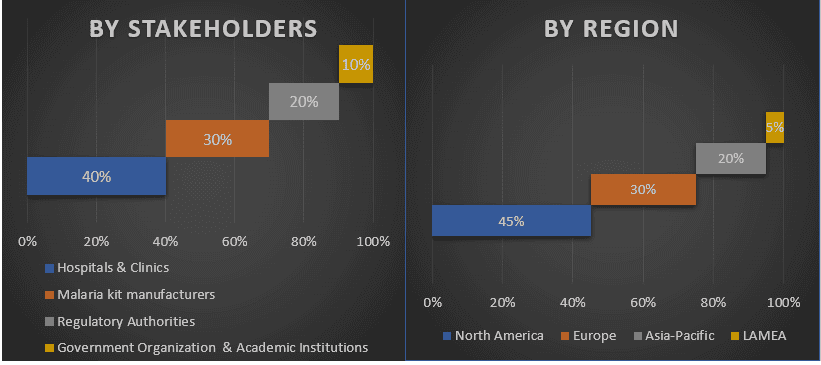- Home
- About Us
- Industry
- Services
- Reading
- Contact Us
Malaria Diagnostics Market: Current Analysis and Forecast (2021-2027)
Emphasis on Technology (Rapid diagnostic tests (RDTs), PCR, Microscopy, ELISA, and Others); End-users (Hospitals, Clinics, and Diagnostics laboratories)); Region/Country

Malaria Diagnostics Market is anticipated to grow with an elevated CAGR of around 5% over the forecast period (2021-2027). The proper treatment for malaria is not available in many parts of the world and people are continuously dying because of this parasitic disease. The unavailability of the proper diagnostic techniques is one of the major causes of fatality in such regions.
With the rapid advancement in technology and rising awareness among the population regarding the severity of the disease along with the continuously increasing malaria cases in the tropical and subtropical regions significantly increasing the market for malaria diagnostics. Furthermore, the government initiatives to control malaria surge the demand for the proper diagnostic techniques. For instance, the government of India has launched the National Framework For Malaria Elimination In India (2016–2030) which outlines India’s strategy for elimination of the disease by 2030. The framework has been developed with a vision to eliminate malaria from the country and contribute to improved health and quality of life and alleviation of poverty.
Access Bio., Inc., Abbott Laboratories, Premier Medical Corporation Pvt. Ltd., Sysmex Partec GmbH, bioMérieux, Beckman Coulter, Inc., Siemens Healthineers, Leica Microsystems GmbH, Nikon Corporation, and Olympus Corporation., are some of the prominent players operating in the Malaria Diagnostics market. Several M&As along with partnerships have been undertaken by these players to facilitate customers with new varieties of Malaria Diagnostics devices.
Insights Presented in the Report
“Amongst Technology, PCR segment holds the major share”
Based on technology, the market is segmented into rapid diagnostic tests (RDTs), PCR, microscopy, ELISA, and others. The PCR segment is expected to have a lucrative market share during the forecast period owing to increasing investment in the research and development of better molecular diagnostic techniques coupled with frequent product launches. For instance, In 2020, PathoDetect Malaria Screening Kit for diagnosis of Malarial parasite by RT-PCR. It is a standardized RT-PCR assay with high accuracy and a combination of validated primers, hydrolysis probes, and hot-start DNA polymerase ensuring that the kit leads to highly-specific and ultrasensitive results in a single step.
“Amongst End-users, hospital segment holds the major share”
Based on end-users, the market is segmented into hospitals, clinics, and diagnostics laboratories. The hospital segment grabbed a significant market share in 2020 and is anticipated to grow at a rapid rate in the upcoming years owing to the rapidly increasing geriatric population and rising prevalence of various chronic diseases. The old-aged people are most susceptible to malaria and it can be more deadly in this age group. For instance, as per the WHO, between 2015 and 2050, the proportion of the world’s population over 60 years will nearly double from 12% to 22%.
“MEA represents one of the largest markets of Malaria Diagnostics market”
For a better understanding of the market dynamics of the Malaria Diagnostics market, a detailed analysis was conducted for different regions across the globe including North America (United States, Canada), Europe (Germany, France, Italy, Spain, United Kingdom, and Rest of Europe), Asia-Pacific (China, Japan, India, and Rest of APAC), Latin America and Middle East & Africa(LAMEA). In 2020, the MEA held a significant share of the malaria diagnostic market and it is also expected to rise during the forecast period. The national and international efforts to eliminate malaria from the region attributed to the growth of the malaria diagnostic market. For instance, the UNHCR launched a malaria action plan for a malaria-free world that is mainly targeted, Africa due to its largest number of malaria cases. The Global Malaria Action Plan will guide and unify the malaria community in its efforts to provide timely and effective assistance to endemic countries with sufficient funding and political support.
Reasons to buy this report:
- The study includes market sizing and forecasting analysis validated by authenticated key industry experts
- The report presents a quick review of overall industry performance at one glance
- The report covers an in-depth analysis of prominent industry peers with a primary focus on key business financials, product portfolio, expansion strategies, and recent developments
- Detailed examination of drivers, restraints, key trends, and opportunities prevailing in the industry
- The study comprehensively covers the market across different segments
- Deep dive regional level analysis of the industry
Customization Options:
The Malaria Diagnostics market can further be customized as per the requirement or any other market segment. Besides this, UMI understands that you may have your own business needs, hence feel free to connect with us to get a report that completely suits your requirements.
Table of Content
Research Methodology for the Malaria Diagnostics Market Analysis (2021-2027)
Analyzing the historical market, estima of the current market, and forecasting the future market of the malaria diagnostics market were the three major steps undertaken to create and analyze the adoption of malaria diagnostics in major regions globally. Exhaustive secondary research was conducted to collect the historical market numbers and estimate the current market size. Secondly, to validate these insights, numerous findings and assumptions were taken into consideration. Moreover, exhaustive primary interviews were also conducted, with industry experts across the value chain of the malaria diagnostics market. Post assumption and validation of market numbers through primary interviews, we employed a top-down/bottom-up approach to forecasting the complete market size. Thereafter, market breakdown and data triangulation methods were adopted to estimate and analyze the market size of segments and sub-segments the industry pertains to. Detailed methodology is explained below:
Seek More Details About Research Methodology
Analysis of Historical Market Size
Step 1: In-Depth Study of Secondary Sources:
Detail secondary study was conducted to obtain the historical market size of the malaria diagnostics through company internal sources such as annual report & financial statements, performance presentations, press releases, etc., and external sources including journals, news & articles, government publications, competitor publications, sector reports, third-party database, and other credible publications.
Step 2: Market Segmentation:
After obtaining the historical market size of the Malaria Diagnostics market, we conducted a detailed secondary analysis to gather historical market insights and share for different segments & sub-segments for major regions. Major segments included in the report as technology and end-users. Further country-level analyses were conducted to evaluate the overall adoption of Malaria Diagnostics across the globe.
Step 3: Factor Analysis:
After acquiring the historical market size of different segments and sub-segments, we conducted a detailed factor analysis to estimate the current market size of the malaria diagnostics. Further, we conducted factor analysis using dependent and independent variables such as the growing number of people with chronic diseases and the increasing elderly population all over the globe. A thorough analysis was conducted for demand and supply-side scenarios considering top partnerships, merger and acquisition, business expansion, and product launches in the Malaria Diagnostics sector across the globe.
Current Market Size Estimate & Forecast
Current Market Sizing: Based on actionable insights from the above 3 steps, we arrived at the current market size, key players in the Malaria Diagnostics market, and market shares of the segments. All the required percentage shares split, and market breakdowns were determined using the above-mentioned secondary approach and were verified through primary interviews.
Estimation & Forecasting: For market estimation and forecast, weights were assigned to different factors including drivers & trends, restraints, and opportunities available for the stakeholders. After analyzing these factors, relevant forecasting techniques i.e., top-down/bottom-up approach was applied to arrive at the market forecast about 2027 for different segments and subsegments across the major markets globally. The research methodology adopted to estimate the market size encompasses:
- The industry’s market size, in terms of value (US$) and the adoption rate of malaria diagnostics across the major markets domestically
- All percentage shares, splits, and breakdowns of market segments and sub-segments
- Key players in the malaria diagnostics market in terms of products offered. Also, the growth strategies adopted by these players to compete in the fast-growing market
Market Size and Share Validation
Primary Research: In-depth interviews were conducted with the Key Opinion Leaders (KOLs) including Top Level Executives (CXO/VPs, Sales Head, Marketing Head, Operational Head, and Regional Head, Country Head, etc.) across major regions. Primary research findings were then summarized, and statistical analysis was performed to prove the stated hypothesis. Inputs from primary research were consolidated with secondary findings, hence turning information into actionable insights.
Split of Primary Participants in Different Regions

Market Engineering
Data triangulation technique was employed to complete the overall market estimation and to arrive at precise statistical numbers of each segment and sub-segment of the malaria diagnostics market. Data was split into several segments & sub-segments post studying various parameters and trends in the areas of product type and application of the Malaria Diagnostics market.
The main objective of the Malaria Diagnostics Market Study
The current & future market trends of malaria diagnostics were pinpointed in the study. Investors can gain strategic insights to base their discretion for investments on the qualitative and quantitative analysis performed in the study. Current and future market trends determined the overall attractiveness of the market at a regional level, providing a platform for the industrial participant to exploit the untapped market to benefit as a first-mover advantage. Other quantitative goals of the studies include:
- Analyze the current and forecast market size of malaria diagnostics in terms of value (US$). Also, analyze the current and forecast market size of different segments and sub-segments
- Segments in the study include areas of technology and end-users
- Define and analysis of the regulatory framework for the malaria diagnostics industry
- Analyze the value chain involved with the presence of various intermediaries, along with analyzing customer and competitor behaviors of the industry
- Analyze the current and forecast market size of the malaria diagnostics market for the major region
- Major regions studied in the report include North America, Europe, Asia-Pacific and LAMEA.
- Company profiles of the Malaria Diagnostics market and the growth strategies adopted by the market players to sustain in the fast-growing market
- Deep dive regional level analysis of the industry
Related Reports
Customers who bought this item also bought










